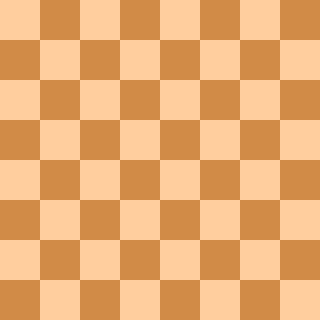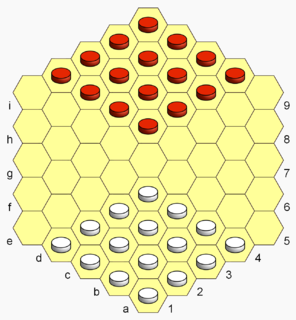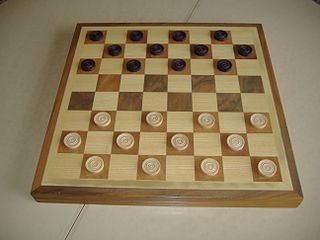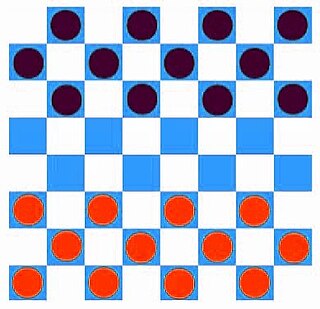 W
WAlquerque is a strategy board game that is thought to have originated in the Middle East. It is considered to be the parent of draughts and Fanorona.
 W
WArmenian draughts, or Tama, is a variant of draughts played in Armenia. The rules are similar to Dama. Armenian draughts, however, allows for diagonal movement.
 W
WBashni, also known as column draughts, multi-level checkers, and rarer Chinese checkers, is a variation of draughts, known in Russia since the 19th century. The game is played according to the basic rules of Russian draughts, with the main difference being that draughts being jumped over are not removed from the playing field but are instead placed under the jumping piece . The resulting towers move across the board as one piece, obeying the status of the upper draught. When a tower is jumped over, only the upper draught is removed from it. If, as a result of the combat, the top draught changes colour, ownership of the tower passes on to the opposing player. Based on Bashni, but according to the basic rules of English draughts, world chess champion Emanuel Lasker developed the draughts game "Laska" and, in 1911, published its description. Lasker described towers that can only be "double-layered": i.e. there can be no alternation of colors. He also showed that during the game the number of game pieces either remains constant or decreases. Column draughts are a subject of interest for the mathematical Sciences: combinatorics, theory of paired zero-sum games, etc.
 W
WBrazilian draughts is a variant of the strategy board game draughts. Brazilian Checkers follows the same rules and conventions as International draughts, the only differences are the smaller gameboard, and fewer checkers per player.
 W
WCanadian checkers is a variant of the strategy board game draughts. It is one of the largest draughts games, played on a 12×12 checkered board with 30 game pieces per player.
 W
WCheskers is a variant of checkers and chess invented by Solomon Golomb in 1948.
 W
WDameo is an abstract strategy board game for two players invented by Christian Freeling in 2000. It is a variant of the game draughts and is played on an 8×8 checkered gameboard.
 W
WEnglish draughts or checkers, also called American checkers or straight checkers, is a form of the strategy board game draughts. It is played on an 8×8 chequered board with 12 pieces per side. The pieces move and capture diagonally forward, until they reach the opposite end of the board, when they are crowned and can thereafter move and capture both backward and forward.
 W
WHexdame is a strategy board game for two players invented by Christian Freeling in 1979. The game is a literal adaptation of the game international draughts to a hexagonal gameboard.
 W
WInternational draughts is a strategy board game for two players, one of the variants of draughts. The gameboard comprises 10×10 squares in alternating dark and light colours, of which only the 50 dark squares are used. Each player has 20 pieces, light for one player and dark for the other, at opposite sides of the board. In conventional diagrams, the board is displayed with the light pieces at the bottom; in this orientation, the lower-left corner square must be dark.
 W
WItalian draughts is a variant of the draughts family played mainly in Italy and Northern Africa. It is a two-handed game played on a board consisting of sixty-four squares, thirty-two white and thirty-two black. There are twenty-four pieces: twelve white and twelve black. The board is placed so that the rightmost square on both sides of the board is black.
 W
WLasca is a draughts variant, invented by the second World Chess Champion Emanuel Lasker (1868–1941). Lasca is derived from English draughts and the Russian draughts game Bashni (Towers).
 W
WPoddavki is a draughts (checkers) game based on the rules of Russian draughts, with the variation that a player wins if they have no legal moves on their turn, either by giving up all their pieces or having them all blocked. As in most varieties of draughts, capturing is mandatory. The game is played in Russia and some parts of the former Soviet Union.
 W
WRussian draughts is a variant of draughts (checkers) played in Russia and some parts of the former USSR, as well as parts of Eastern Europe and Israel.
 W
WTanzanian draughts is a variant of draughts (checkers) board game played usually in Tanzania. This is the strategy game that is played by two people using pieces on board. The game is very similar to Czech draughts but in this type the player can capture using king or men, there is no priority for that. Apart from that they are completely similar in any way. The game is also somehow similar American checkers and Shashki in case of starting position however rules of playing Tanzanian checkers differ. Like many other kinds of draughts, there is possibility that either player can win the game or draw can be offered but this is based on the negotiations of players or supporters of the game.
 W
WTurkish draughts is a variant of draughts (checkers) played in Turkey, Greece, Egypt, Kuwait, Lebanon, Syria, Jordan and several other locations around the Mediterranean Sea and Middle East.